LG To Mass Produce Shatter-Proof, Plastic-Based OLED Displays This July
LG and Samsung have started selling "curved" display devices since last year, but neither company has produced so far what could be described as unbreakable or shatter-proof. The current bendable displays are glass-based and can only provide a limited 75 mm bending radius. LG is now working on plastic-based OLED displays that are much more flexible and have an increased bending flexibility of 30 mm radius.
Besides being able to make curved screens, which may or may not be of value to the regular user, LG could also make screens that don't shatter when the device is dropped. Many people drop their devices accidentally, and repairs tend to be quite expensive. If you buy a low-end smartphone, it might not even be worth it to replace its touchscreen, as the replacement could end up costing almost as much as the new device.
LG's main trouble in switching from glass-based OLED displays to plastic-based ones was in providing the same level of energy efficiency, luminance and color accuracy. The new plastic-based OLED display from LG has an efficiency of 60 lumens/Watt, an 807 nits peak brightness output, 3000K color temperature and a CRI (Color Rendering Index) of 85.
The display may not qualify as one of the best in terms of image quality compared to other glass-based displays right now, but it could get quite close, and LG should continue to improve those aspects of the technology over the coming years.
LG intends to use it not just in smartphones, but also in tablets, wearables, PC monitors, TVs, car dashboards, and even for interior design. In 2017, LG hopes to be able to create foldable computers. That may be a little optimistic, as the industry will also need to provide us with foldable chips, RAM, flash memory and other components that go into making a mobile device for that to be possible. Alternatively, hardware makers could just put the components somewhere at the edges of the display, so only the display itself could fold around those "harder" edges. It wouldn't be a truly flexible device, but it could help put larger screen in a smaller footprint.
LG will start mass producing the new plastic-based OLED displays in July. It's not clear whether we'll see them in the company's LG G4 or G5, but it may appear in an even more curved and shatter-proof LG G Flex 3.
Follow us @tomshardware, on Facebook and on Google+.
Get Tom's Hardware's best news and in-depth reviews, straight to your inbox.
Lucian Armasu is a Contributing Writer for Tom's Hardware US. He covers software news and the issues surrounding privacy and security.
-
MyDocuments You see, our distant relatives had it right, scrolls were more portable than books, the idea of roll-able displays were not lost on them. Next we'll be heading back to tablets, albeit not made of stone... oh, wait a minute!Reply -
Avus I don't need OLED can be bent or curved... I just need them to be cheap... So I can buy my next 55" TV using OLED....Reply -
Simon Mackay Personally, I would like to see mono and colour OLED replace LCD as the preferred display choice for AC-operated equipment. This means that the manufacturers don't need to implement deep display devices like VFD tubes or backlit LCDs, and allows them to make their devices a bit more special.Reply -
kenjitamura ReplyI don't need OLED can be bent or curved... I just need them to be cheap... So I can buy my next 55" TV using OLED....
Don't think they'll be cheap anytime soon. But Quantom Dot technology is starting to take off which just requires an extra layer of film be added to LED LCD Tv's and it improves color reproduction of LCD's to the point it rivals OLED. This technology so far inflates the price of an LCD TV from around 30-50% which still is a good deal cheaper than OLED TV's. And as Quantom Dots see increased usage their prices will drop. I'm personally hoping to see some IPS QD computer monitors with Freesync support hit the market.
-
photonboy Quantum Dot does NOT rival OLED. I'm not sure why people keep claiming this.Reply
There's still a backlight and thus light bleed in Quantum Dot that means that it will never have black levels as dark as OLED can do.
This has been reported several times, though there is an article floating around that's totally incorrect (he said each pixel could control its own brightness in QDot). -
photonboy (I meant the incorrect article said each pixel could control their own brightness including turning off completely which is false because again there's light bleed with the LCD panel as always. QDot's are on the backlight itself. The LCD panel still exists to filter the light)Reply -
gio2vanni86 1x1 inch screen folds out to be a 50inch 4k display.. I can dream right. Fold-able tech in my early 30's thats cool too.Reply -
haftarun8 photonboy is completely correct. It's more like OLED > Plasma >>>> QDot > LCD in terms of overall potential image quality. Companies need to stop throwing band-aids at and resuscitating ancient LCD technology...since Plasma is dying due to mainly public ignorance of its quality and the false notion that burn-in is still a problem (it isn't), we need to embrace the future!!!Reply


